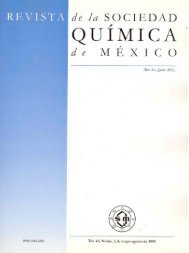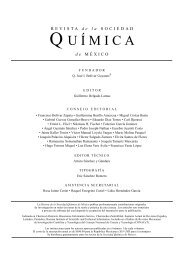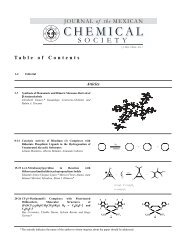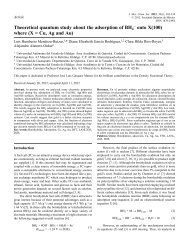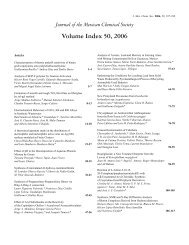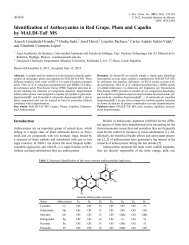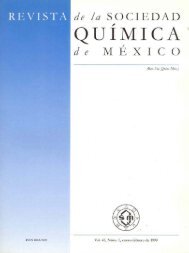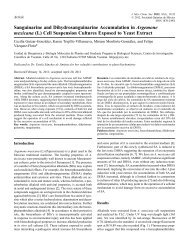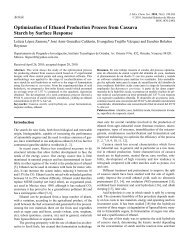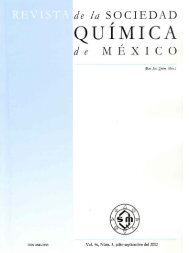SMQ-V047 N-002_ligas_size.pdf - Journal of the Mexican Chemical ...
SMQ-V047 N-002_ligas_size.pdf - Journal of the Mexican Chemical ...
SMQ-V047 N-002_ligas_size.pdf - Journal of the Mexican Chemical ...
You also want an ePaper? Increase the reach of your titles
YUMPU automatically turns print PDFs into web optimized ePapers that Google loves.
204 Rev. Soc. Quím. Méx. Vol. 47, Núm. 2 (2003) Erick Cuevas Yañez et al.<br />
Table 2. Selected bond distances (Å) and angles (°) for 1.<br />
Bond<br />
Distance (Å)<br />
S1-C13 1.689(8)<br />
O1-C1 1.221(9)<br />
O2-C9 1.440(8)<br />
N1-C2 1.316(9)<br />
C1-C3 1.483(9)<br />
C3-C4 1.409(9)<br />
C3-C8 1.407(10)<br />
C4-C5 1.370(9)<br />
S1-C10 1.707(9)<br />
O2-C4 1.366(9)<br />
N1-N2 1.117(8)<br />
C1-C2 1.433(12)<br />
C9-C10 1.487(10)<br />
C11-C12 1.419(11)<br />
Fig. 2. ORTEP representation for compound 1.<br />
because <strong>the</strong>re are not overwhelming evidences about <strong>the</strong> reaction<br />
mechanism. The McKervey group [7-9] found that varying<br />
<strong>the</strong> catalyst <strong>the</strong>y could modify <strong>the</strong> course <strong>of</strong> this kind <strong>of</strong><br />
reactions to obtain both chromanones and benz<strong>of</strong>uranones.<br />
However, <strong>the</strong> five-membered ring formation and subsequent<br />
Stevens rearrangement is more common in <strong>the</strong>se processes<br />
[10].<br />
Treatment <strong>of</strong> diazoketone 1 with rhodium (II) acetate in<br />
dichloromethane at room temperature under inert atmosphere<br />
gave a reaction product whose physical and spectroscopic<br />
constants did not correspond to those expected for chromanone<br />
8 as have been reported previously [11, 12]. In this way,<br />
spectroscopic data indicated that <strong>the</strong> compound obtained was<br />
thienylmetylbenz<strong>of</strong>uranone 10. Additionally, Gefflaut and<br />
Périe [13] informed a similar cyclization process when <strong>the</strong><br />
diazoketone derived from 2-benzyloxybenzoic acid reacted<br />
with catalytic rhodium (II) acetate. Therefore, in this case <strong>the</strong><br />
carbenoid 7 derived from <strong>the</strong> diazoketone 1 reacted in an<br />
intramolecular way with <strong>the</strong> phenoxy oxygen to generate a<br />
five-membered ring and also an oxonium ylide which is<br />
kinetically favored and is rearranged later to <strong>the</strong> benz<strong>of</strong>uranone<br />
10.<br />
In conclusion, this work presents <strong>the</strong> first syn<strong>the</strong>sis <strong>of</strong> <strong>the</strong><br />
2-diazo-1-[2-(thiophen-2-ylmethoxy)-phenyl]-ethanone 1 and<br />
its intramolecular cyclization to <strong>the</strong> benz<strong>of</strong>uranone 10, which<br />
expands <strong>the</strong> possibilities to carry out reactivity studies with<br />
transition metals and to syn<strong>the</strong><strong>size</strong> some derivatives from this<br />
molecule.<br />
Experimental section<br />
Bond Angle (°)<br />
C13-S1-C10 92.0(5)<br />
N2-N1-C2 177.0(10)<br />
O1-C1-C3 121.6(8)<br />
N1-C2-C1 115.0(8)<br />
C8-C3-C1 116.4(6)<br />
O2-C4-C5 124.0(7)<br />
C5-C4-C3 120.6(7)<br />
C11-C10-C9 126.1(8)<br />
C9-C10-S1 122.3(6)<br />
C4-O2-C9 117.4(5)<br />
O1-C1-C2 121.0(6)<br />
C2-C1-C3 117.3(7)<br />
C8-C3-C4 117.9(6)<br />
C4-C3-C1 125.7(7)<br />
O2-C4-C3 115.4(6)<br />
O2-C9-C10 108.2<br />
C11-C10-S1 111.5(6)<br />
The starting materials were purchased from Aldrich <strong>Chemical</strong><br />
Co. and were used without fur<strong>the</strong>r purification. Solvents were<br />
distilled before use, e<strong>the</strong>r and tetrahydr<strong>of</strong>uran (THF) were<br />
dried over sodium using benzophenone as indicator. Diazomethane<br />
was prepared from N-methyl-N-nitroso-p-toluenesulfonamide<br />
(Diazald ®) using a minimum amount <strong>of</strong> water and<br />
ethanol as co-solvent, and dried over KOH pellets before use.<br />
Silica gel (230-400 mesh) and neutral alumina were purchased<br />
from Merck. Silica plates <strong>of</strong> 0.20 mm thickness were used for<br />
thin layer chromatography. Melting points were determined<br />
with a Fisher-Johns melting point apparatus and <strong>the</strong>y are<br />
uncorrected. 1 H and 13 C NMR spectra were recorded using a<br />
Varian Gemini 200, chemical shifts (d) are given in ppm relative<br />
to TMS as internal standard (0.00). For analytical purposes,<br />
mass spectra were recorded on a JEOL JMS-5X 10217 in<br />
<strong>the</strong> EI mode, 70 eV, 200 °C via direct inlet probe. Only molecular<br />
and parent ions (m/z) are reported. IR spectra were<br />
recorded on a Nicolet Magna 55-X FT instrument. For X-Ray<br />
diffraction studies, crystals <strong>of</strong> compound 1 were obtained by<br />
slow evaporation <strong>of</strong> a dilute ethanol solution, and reflections<br />
were acquired with a Nicolet P3 / F diffractometer. Three<br />
standard reflections every 97 reflections were used to monitor<br />
crystal stability. The structure was solved by direct methods,<br />
missing atoms were found by difference-Fourier syn<strong>the</strong>sis,<br />
and refined on F2 by a full-matrix least-squares procedure<br />
using an isotropic displacement parameters using SHELX-97.




